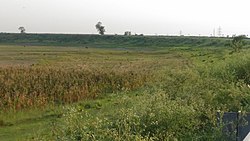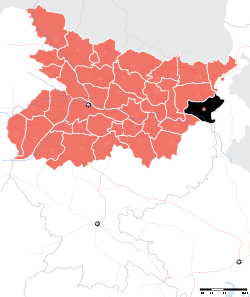Katihar district
Katihar district is one of the thirty-eight districts of Bihar state, India, and Katihar city is the administrative headquarters of this district. The district is a part of Purnia Division. One important thing is Katihar railway station is one of the biggest railway station in Bihar.
Katihar district | |
|---|---|
District of Bihar | |
 | |
 | |
 Location of Katihar district in Bihar | |
| Country | India |
| State | Bihar |
| Division | Purnia |
| Headquarters | Katihar |
| Tehsils | 17 |
| Government | |
| • Lok Sabha constituencies | Katihar |
| • Vidhan Sabha constituencies | Katihar, Kadwa, Balrampur, Pranpur, Manihari, Barari korha (vidhan sabha constituency ) korha |
| Area | |
| • Total | 3,056 km2 (1,180 sq mi) |
| Population (2011) | |
| • Total | 3,071,029 |
| • Density | 1,000/km2 (2,600/sq mi) |
| Demographics | |
| • Sex ratio | 916 |
| Time zone | UTC+05:30 (IST) |
| Major highways | NH-31, NH-81, NH-131A |
| Website | http://katihar.bih.nic.in/ |
History
Katihar district, which was previously part of Purnia district, is part of the Mithila region.[1] Mithila first gained prominence after being settled by Indo-Aryan peoples who established the Mithila Kingdom (also called Kingdom of the Videhas).[2]
During the late Vedic period (c. 1100–500 BCE), Kingdom of the Videhas became one of the major political and cultural centers of South Asia, along with Kuru and Pañcāla. The kings of the Kingdom of the Videhas were called Janakas.[3] The Mithila Kingdom was later incorporated into the Vajji confederacy, which had its capital in the city of Vaishali, which is also in Mithila.[4]
Later it was dominated by chaudhary family who were the biggest landlord of katihar district. khan Bahadur Mohammad Baksh was the founder of Chaudhary family. Family hold 15000 acre land in katihar district and 8500 acre land in Purnea district. His greatgrandsons Chaudhary Mohammad Ashraf and Chaudhary Taj Mohammad live in a haveli known as Taj dehori. Katihar became a district when it was split from Purnia in 1973.[5]
Geography
Katihar district occupies an area of 3,057 square kilometres (1,180 sq mi),[6] comparatively equivalent to Canada's Akimiski Island.[7]
Rivers: Mahananda, Ganges, Koshi, Righa
Katihar district is situated in the plains of North Eastern part of Bihar State, surrounded by Purnea district (Bihar) in the north and the west, Bhagalpur district (Bihar) and Sahebganj district (Jharkhand) in the south and Malda district and Uttar Dinajpur district (Paschim Bengal) in the east.
Economy
In 2006, the Ministry of Panchayati Raj named Katihar one of the country's 250 most backward districts (out of a total of 640).[8] It is one of the 36 districts in Bihar currently receiving funds from the Backward Regions Grant Fund Programme (BRGF).[8]
Political history
The Katihar Lok Sabha constituency has been represented by politicians like Sitaram Kesri former Teasurer and President of AICC, Tariq Anwar, Nikhil Choudhary, Mohammad Yunus Saleem. Mufti Mohammad Sayeed also unsuccessfully tried his luck.
The district has seen immense activity during freedom struggle. There has been renowned freedom fighters like Alhaj Azhar Ali after whose name there is a village called Ajhrail. Among notable freedom fighters were Dhrub Kundu his father Dr kundu Nakshtra Malakar known as Robinhood of Kosi belt.
Sports Karate history
The first Karate training institute namely Tigers Martial Arts Academy Katihar started at Moffar Ganj in the year 1979-80 by Tiger Nasim Khan. TMAA is the first Karate Institution of Katihar District.
Tiger Nasim Khan is the founder of Karate of Katihar district.
TMAA Shotokan Karate Do Association INDIA is the first Internationally recognised Karate Association of Bihar from 1994. TMAA Shotokan Karate Do Association INDIA is also recognised by KARATE ASSOCIATION OF INDIA.
Sub-divisions
Katihar District comprises 3 Sub-divisions:
- Katihar
- Barsoi
- Manihari
Katihar sub-division is further divided into 10 blocks: Katihar, Korha, Falka, Sameli, Barari, Kursela, Pranpur, Hasanganj, Dandkhora and Mansahi. Barsoi sub-division consists 4 blocks: Barsoi, Kadwa, Azamnagar and Balrampur. Manihari sub-division has 2 blocks: Manihari and Amdabad.
Hasanganj being the largest block which was under the zamindari rule with acres of land under the possession of then Late Shri Jogendranarayan Roy Choudhury. The entire landmass with school, temple and market has been donated to the people from the predecessors who remain in Katihar now with little of the possession under the Paul Choudhury fame. Mansahi was also very active zamindari estate which was at par with Kursela and Falka.
Demographics
According to the 2011 census, Katihar district has a population of 3,071,029,[9] roughly equal to the nation of Oman[10] or the US state of Iowa.[11] This gives it a ranking of 117th in India (out of a total of 640).[9] The district has a population density of 1,004 inhabitants per square kilometre (2,600/sq mi).[9] Its population growth rate over the decade 2001–2011 was 28.23%.[9] Katihar has a sex ratio of 916 females for every 1000 males,[9] and a literacy rate of 53.56%.[9] The district has a significant concentration of Muslims.[9]
At the time of the 2011 Census of India, 73.91% of the population in the district spoke Hindi, 12.04% Bengali, 9.11% Urdu, 2.97% Santali, 0.64% Kurukh and 0.60% Maithili as their first language.[12]
| Year | Pop. | ±% p.a. |
|---|---|---|
| 1901 | 484,667 | — |
| 1911 | 520,805 | +0.72% |
| 1921 | 556,136 | +0.66% |
| 1931 | 601,533 | +0.79% |
| 1941 | 654,841 | +0.85% |
| 1951 | 694,986 | +0.60% |
| 1961 | 911,037 | +2.74% |
| 1971 | 1,136,994 | +2.24% |
| 1981 | 1,428,622 | +2.31% |
| 1991 | 1,825,380 | +2.48% |
| 2001 | 2,392,638 | +2.74% |
| 2011 | 3,071,029 | +2.53% |
| source:[13] | ||
References
- Jha, Makhan (1997). Anthropology of Ancient Hindu Kingdoms: A Study in Civilizational Perspective. ISBN 9788175330344.
- Michael Witzel (1989), Tracing the Vedic dialects in Dialectes dans les litteratures Indo-Aryennes ed. Caillat, Paris, pages 13, 17 116–124, 141–143
- Witzel, M. (1989). "Tracing the Vedic dialects". In Caillat, C. (ed.). Dialectes dans les litteratures Indo-Aryennes. Paris: Fondation Hugot. pp. 141–143.
- Hemchandra, R. (1972). Political History of Ancient India. Calcutta: University of Calcutta.
- Law, Gwillim (2011-09-25). "Districts of India". Statoids. Retrieved 2011-10-11.
- Srivastava, Dayawanti et al. (ed.) (2010). "States and Union Territories: Bihar: Government". India 2010: A Reference Annual (54th ed.). New Delhi, India: Additional Director General, Publications Division, Ministry of Information and Broadcasting (India), Government of India. pp. 1118–1119. ISBN 978-81-230-1617-7.CS1 maint: extra text: authors list (link)
- "Island Directory Tables: Islands by Land Area". United Nations Environment Program. 1998-02-18. Retrieved 2011-10-11.
Akimiski Island 3,001km2
- Ministry of Panchayati Raj (September 8, 2009). "A Note on the Backward Regions Grant Fund Programme" (PDF). National Institute of Rural Development. Archived from the original (PDF) on April 5, 2012. Retrieved September 27, 2011.
- "District Census 2011". Census2011.co.in. 2011. Retrieved 2011-09-30.
- US Directorate of Intelligence. "Country Comparison:Population". Retrieved 2011-10-01.
Oman 3,027,959
- "2010 Resident Population Data". U. S. Census Bureau. Archived from the original on 2011-01-01. Retrieved 2011-09-30.
Iowa 3,046,355
- 2011 Census of India, Population By Mother Tongue
- Decadal Variation In Population Since 1901